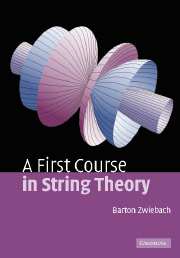Book contents
- Frontmatter
- Contents
- Foreword
- Preface
- Acknowledgements
- Part I Basics
- Part II Developments
- 14 D-branes and gauge fields
- 15 String charge, electric charge, and particle physics
- 16 String thermodynamics and black holes
- 17 T-duality of closed strings
- 18 T-duality of open strings
- 19 Electromagnetic fields on D-branes
- 20 Nonlinear and Born–Infeld electrodynamics
- 21 Covariant string quantization
- 22 String interactions and Riemann surfaces
- 23 Loop amplitudes in string theory
- References
- Index
22 - String interactions and Riemann surfaces
from Part II - Developments
- Frontmatter
- Contents
- Foreword
- Preface
- Acknowledgements
- Part I Basics
- Part II Developments
- 14 D-branes and gauge fields
- 15 String charge, electric charge, and particle physics
- 16 String thermodynamics and black holes
- 17 T-duality of closed strings
- 18 T-duality of open strings
- 19 Electromagnetic fields on D-branes
- 20 Nonlinear and Born–Infeld electrodynamics
- 21 Covariant string quantization
- 22 String interactions and Riemann surfaces
- 23 Loop amplitudes in string theory
- References
- Index
Summary
The world-sheets of interacting open strings are recognized to be Riemann surfaces, and interaction processes are seen to construct the moduli spaces of these surfaces. Conformal mapping is used to provide canonical presentations for interacting lightcone world-sheets. The celebrated Veneziano amplitude for the interaction of open string tachyons is motivated and discussed.
Introduction
Interactions and the forces that mediate them make the world interesting. If the electron and the proton did not interact, there would be no hydrogen atom. The fine structure constant α = e2/(4πħc) quantifies the strength of electromagnetic interactions and determines the interaction potential between the electron and the proton (see Section 13.4). The hot filament of a light bulb emits photons, some of which are absorbed by your eye. Emission and absorption processes are also interactions. A neutron can turn into a proton, an electron, and an antineutrino. This process, called β-decay, is the result of a weak interaction.
In string theory the strength of interactions is parameterized by the string coupling g.
The value of this dimensionless number is determined by the expectation value of the dilaton field, as we discussed in Section 13.4. The string coupling g, together with the slope parameter α′, determines the value of Newton's constant. The constants g and α′ also determine the tension of D-branes.
- Type
- Chapter
- Information
- A First Course in String Theory , pp. 481 - 517Publisher: Cambridge University PressPrint publication year: 2004



